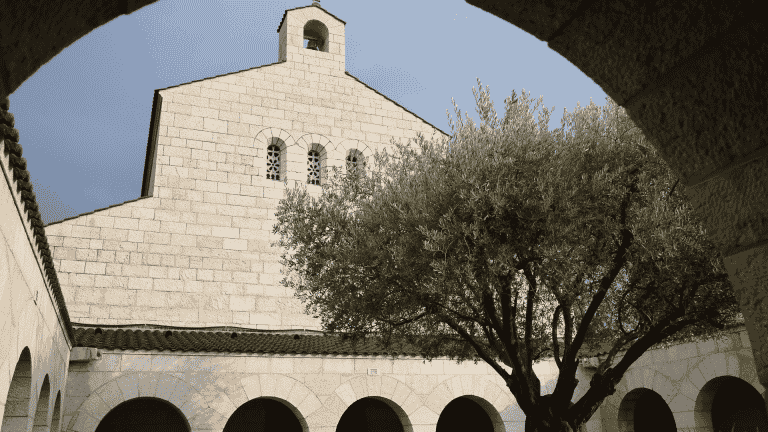Of episodes of multiplication of the loaves, the four Gospels abound. There are six in all, with the Gospels of Mark and Matthew even telling two consecutive ones. Yet, in the midst of this abundance, what is missing, as is often the case, are the geographical details that can help identify the place where these miracles took place.
Matthew speaks only vaguely of movements on the "Sea of Galilee", and only at the conclusion of the second multiplication of the loaves does he report that Jesus, having climbed on a boat, moved to the "region of Magadán". A location that, however, is not clearly known to us today. Marco sets both episodes of multiplication in desert regions, specifying only indirectly that these are areas close to Lake Tiberias. Luke and John speak of Jesus ' movements followed by a large crowd. For Luke, the Master was near Bethsaida, whose location we do not know today; for John, near a mountain above Lake Tiberias. No other specification is provided.
The Evangelical Tradition
In short, the Evangelical tradition does not clearly identify a point where the miracle of the multiplication of the loaves would have taken place. Although it is believed that the Magadàn of which Matthew speaks is Magdala, the problem would not be solved: Jesus reaches Magadàn by boat after performing the miracle. So where was he doing it?
The Christian tradition of the following centuries helps to identify a precise place. Two pilgrims who frequented the Holy Land between the fifth and sixth centuries, Egeria and Theodosius, claim to have visited the exact place where the multiplication of the loaves for the five thousand had happened (it is, for example, the episode of which Luke speaks). It is a locality on the northern shore of Lake Tiberias, near Tabgha.
The church of Tabgha
Here, a few steps from the sanctuary that commemorates the delivery of the apostolic primacy to Peter, stands today a harmonious and elegant church, which takes the name of "sanctuary of the multiplication of the loaves". This building was built in the 80s taking up the lines of a pre-existing Byzantine building, brought to light in some excavation campaigns of the early 20th century.
The archaeological campaigns conducted in Tabgha in 1911 and 1931, in fact, had revealed the foundations of two Byzantine buildings in this locality on the shores of Lake Tiberias. Numerous mosaics had also been brought to light that embellished this place of worship, certainly particularly precious for being so richly decorated. In particular, the famous floor mosaic bearing the basket of loaves and two fish, still visible today in the sanctuary, was rediscovered.
In 1969, a powerful earthquake also shook the town of Tabgha, raising the ground. This posed a great risk to the integrity of the mosaics, so it was decided to remove them and cement them again. When, a dozen years later, the modern sanctuary was built, it was decided to guarantee these extraordinarily representative mosaics a new, more central location. That is why the pavement with the basket of loaves and fishes was brought in front of the altar, in the presbytery, instead of being kept behind it, as it was in Byzantine times.
The mystery of the four loaves
At a non-superficial glance, one immediately notices that the mosaic now in front of the altar does not contain five loaves, as some Evangelical narratives want, but only four. For a long time there has been questioning the matter, and wondering if the artist's license was creativity or inattention. Today, there is a very interesting explanation, which also helps to understand why it was decided to build the sanctuary precisely in this locality; even if the Gospels do not identify it precisely.
The basket would contain only four loaves because the fifth, missing in the mosaic, is the one placed on the altar during the daily mass. The artist would have liked to emphasize, in short, that in the miracle of the multiplication of the loaves, central is the community gathered around the table established by the Lord. This helps to understand the reason for the construction of the shrine right near Tabgha, even in the absence of explicit evangelical indications.
The location, in fact, is particularly problematic. Jesus would have arrived by boat in the area of Magdala – according to Matthew – and therefore would have been quite far from this city; and Tabgha, on the other hand, is quite close. In addition to this, the northern area of the Lake, where the sanctuary stands, has always been very inhabited. And this contrasts with the information that the miracle happened in 'desert' places. Added to this is the difficulty of identifying Tabgha with the 'Bethsaida' of which Luke speaks.
The importance of community
However, if we accept the explanation for which the sanctuary of the multiplication of the loaves puts the Eucharist at the center, more than the fact of the miracle itself, the location is explained. It would have been decided to build the church in a densely populated place to favor the community in its participation in the Eucharistic banquet. Although this place, with excellent probability, was not the historical site of the miracle.
In short, the sanctuary is a valid help to our communities to remember a historical gesture, which is replicated around each altar on which Mass is celebrated. Of the exact place where Jesus was, perhaps, we will never have enough news. But after all, this is less important!












